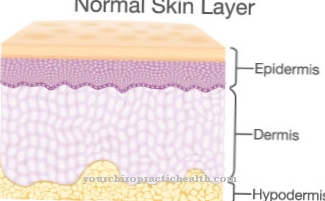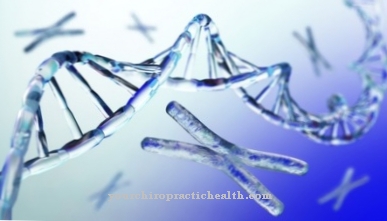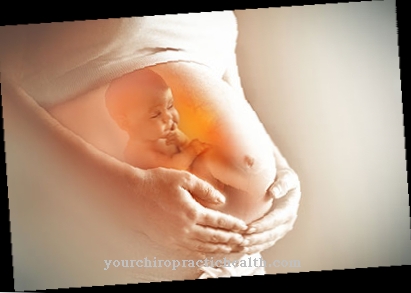Palpation of the breast is a standard check at every visit to the gynecologist. Even at home, the breast should be checked regularly for lumps. Usually it is benign breast tumors and no symptoms of cancer, but this should always be checked by a doctor.
What are benign breast tumors?

Benign breast tumors, also called benign tumors of the breast, are changes in the breast that are not considered to be pathological. A benign tumor does not have breast cancer. There are several types of these benign changes:
An overgrowth of the connective and glandular tissue is called a fibroadenoma. It can be felt as a clearly delineated knot.
A lipoma is an overgrowth of adipose tissue cells and is usually very small. The phylloid tumor is similar to the fibroadenoma. It also grows out of the connective tissue, but can very quickly become very large and even malignant. This type of benign breast tumor is rather rare.
Another rare tumor is the intraductal or ductal papilloma. The growth arises from the lining tissue of the mammary gland ducts. The cauliflower-like, small tumor is usually just below the nipple.
Slowly growing and small growths of the glandular tissue are called adenomas. They are also rather rare.
causes
Most benign breast tumors are harmless. Where they come from is not yet fully covered. One cause could be hormonal influences. For example, factors such as taking birth control pills, pregnancy and breastfeeding seem to reduce the risk of developing tumors.
Breast tissue is very sensitive to fluctuations in estrogen and progesterone levels during the menstrual cycle. Furthermore, benign breast tumors occur mainly in young women.
Infection can also cause breast lumps. Inflammation of the breast tissue is called mastitis. It is particularly common in women who are breastfeeding. If the skin of the nipple is injured while breastfeeding, bacteria can easily enter and cause an infection.
Women who wear a nipple piercing are particularly at risk for infection. Other causes of benign breast tumors can include regular breast tissue changes, injuries, or medication.
Symptoms, ailments & signs
Benign breast tumors belong to different types of tumors and therefore cause different symptoms. Often there are no complaints at all. However, the symptoms that may occur depend on the type of tumor. The benign breast tumors include fibroadenomas, adenomas, lipomas, phyllodes, and the intraductal papilloma.
Usually young women are affected. Fibroadenomas are the most common benign breast tumors. These usually do not cause any discomfort. They are mostly accidentally felt as hard knots during a breast self-examination. Only in very slim women can the lumps be discovered as swelling by sight if they are directly under the skin.
Symptoms only occur in rare cases during pregnancy because there may be inflammation. Unlike fibroadenomas, lipomas are soft to the touch. But lipomas do not cause any symptoms either. The so-called phyllodes tumors are easy to feel, as they grow very quickly and can reach a considerable size. As the tumor grows against the breast skin, it often bulges out.
Sometimes it grows through the skin and then looks like cauliflower. The intraductal papilloma is difficult to feel due to its softness. However, it is noticeable as a milky discharge from the nipple. A bloody discharge can also occur with adenoma of the nipple. A malignant degeneration occurs only very rarely in benign breast tumors.
Diagnosis & course
The benign breast tumors often show no symptoms up to a certain size. With the duct papilloma, a bloody or milky discharge can occur from the nipple.
Usually, however, the lump is only discovered when it is large enough to be felt. An important diagnostic tool is therefore self-examination, i.e. palpating your own breast. It is also important to pay attention to special features of the knot, for example whether it changes during the menstrual cycle.
If a lump is discovered, the gynecologist should be consulted. He scans the breast precisely and, if necessary, orders an ultrasound examination (sonography) or a mammography.
To determine whether the tumor is benign or malignant, a small sample of tissue is taken (biopsy) and examined. The benign breast tumors usually grow slowly, do not destroy the surrounding tissue and do not form metastases. That is why the forecasts are usually positive and the course favorable.
Palpation of the breast is a standard check at every visit to the gynecologist. Even at home, the breast should be checked regularly for lumps yourself. Most of the time, these are benign breast tumors and not symptoms of cancer, but this should always be checked by a doctor.
Complications
A lump in the breast always means that an ulcer is growing, which should be noted. It does not matter whether it is the female or male breast. Breast lumps occur in both sexes and must be professionally examined at all times.
Without treatment, they can continue to grow unhindered and cause great damage. And it is not just growing that is a problem. Even if it is a harmless hardening, it can turn into a malignant tumor without treatment. Only a doctor can determine what type of tumor it is.
Complications of treated breast lumps occur when wound care is not performed aseptically. There is inflammation at the surgical site or the scar does not close. If a malignant tumor has been diagnosed, complications from chemotherapy can occur.
If the person concerned has waited too long and diseased cells were able to get into the lymphatic system, so-called elephantiasis occurs. The arm becomes unnaturally thick and very rarely does the swelling go away, even with special treatments.
When should you go to the doctor?
If there is a lump in the breast tissue, a doctor should always be consulted. Both men and women should immediately seek a medical check-up as soon as there are any noticeable hardening or other changes within the breast tissue. If there is swelling, ulcer formation, skin changes or discoloration, a doctor must be consulted.
If pain occurs or if bruises are repeatedly noticed on the chest without any external influences, it is necessary to consult a doctor. If there is a pulling sensation in the chest during movement sequences or if there are problems when performing general activities, a doctor is required. If the breast grows abnormally, if you notice a feeling of tightness in the chest, or if there are changes in the sensations on the skin, you should see a doctor.
Caution should be exercised in the case of numbness or sensitivity disorders of the chest and a doctor should be consulted. If changes or irregularities develop in patients with diagnosed benign tumors, a doctor must be consulted immediately.
In some cases, benign tumors can turn into malignant disease. Another inspection visit is therefore necessary as soon as possible. If fluid is lost through the nipple, this is considered unusual and should be investigated. A doctor should also be consulted in the event of internal restlessness, psychological problems or behavioral problems.
Doctors & therapists in your area
Treatment & Therapy
Treatment depends on what type of benign breast tumor you have. Inflammation of the breast tissue in a woman who is breastfeeding can be treated with antibiotics and warm compresses. If an abscess has formed, it often first has to be drained from the art.
Milky duct papillomas can develop into malignant tumors in individual cases. Therefore, they must be checked regularly and possibly surgically removed.
Most benign breast tumors are removed surgically. If the patient is not particularly suffering, it is often sufficient to observe very small, slowly growing growths and to check them regularly. Benign breast tumors rarely develop into a malignant tumor disease. They also usually do not increase the risk of breast cancer.
In the case of the rare phyllodes tumor, it is important that the tumor is completely removed, otherwise it can form again after the operation. Usually the entire breast does not have to be removed for this.
Outlook & forecast
Benign breast tumors generally have a very favorable prognosis. An important reason for this is the slow growth of the affected cells. In contrast to malignant tumors, the surrounding tissue is not destroyed and metastases do not form.
The likelihood of degeneration, that is, of turning into a malignant tumor, is very low in benign breast tumors. Since the likelihood increases somewhat with increasing age, surgical removal is generally performed more often in older patients.
For some small and sporadic tumors such as fibroadenomas, regular gynecological checks are sufficient. A negative course is not to be expected.
As a rule, however, surgical removal is aimed for even with benign breast tumors. These tumors often go unnoticed for a long time. Nevertheless, they grow and can gradually displace healthy tissue and cause immense damage.
The benign phylloid tumor often recovers after surgery. Therefore, this tumor in particular must be completely removed. Breast removal is usually not necessary for benign breast tumors. The prognosis for complete healing after removal of a breast tumor is very good.
prevention
So far, no special measures are known to reduce the risk of benign breast tumors. Treatment as early as possible is particularly important. Regular self-examinations and regular checks by the gynecologist are essential for this. Every newly discovered lump should be clarified by the gynecologist and known benign breast tumors that have not been removed should be checked regularly.
Aftercare
In the case of benign breast tumors, various follow-up measures are usually necessary. Usually the tumor or tumors are surgically removed. The surgical scars in this area usually heal well. Therefore, only a few postoperative check-ups are necessary. However, intensive follow-up care is necessary if complications such as inflammation arise.
After the benign breast tumor has been successfully removed, the follow-up examinations aim primarily to detect a recurrence of tumors in good time. Certain types of tumors strongly stimulate the growth of the surrounding tissue. This leads to the formation of new ulcers. This also partially increases the risk of malignant tumors.
The control intervals after the removal of benign breast tumors are determined in consultation with the specialist. The breast should be examined several times a year by a doctor within the first five years. A mammography and sonography should be performed at least once a year.
In addition, those affected should feel the breast themselves to detect any changes in the tissue. If there is hardening, skin changes or other abnormalities in the breast area, a specialist should be consulted regardless of the scheduled examination intervals. This is also advisable if tumors develop in other parts of the body, such as under the armpit.
You can do that yourself
Benign breast tumors usually do not require any therapeutic treatment, so that those affected do not usually need to help themselves in everyday life. The growth of benign tumors such as the fibroadenoma cannot be influenced by oneself anyway.
Sometimes it is possible that a fibroadenoma, due to its location or size, can cause pressure or, in the context of PMS and other menstrual disorders, can make symptoms such as chest pain before the period somewhat worse.In these cases, cooling compresses with quark are an effective home remedy with absolutely no side effects. In addition, as with other breast complaints (such as mastopathy), it is recommended not to constantly touch the breast or a possibly noticeable benign breast tumor.
There are cases when a woman also has poor mental health with the fact that she has a benign breast tumor. After a confirmed diagnosis by the specialist, for example through imaging procedures or a biopsy, it is then important that the woman does not develop excessive fears of the benign tumor.
Targeted information about the harmlessness of the diagnosis and consistent compliance with conventional preventive examinations as part of cancer screening help here. If the benign tumor remains inconspicuous, the woman can deal with the diagnosis in an increasingly relaxed and relaxed manner in everyday life.


.jpg)


.jpg)


















.jpg)



